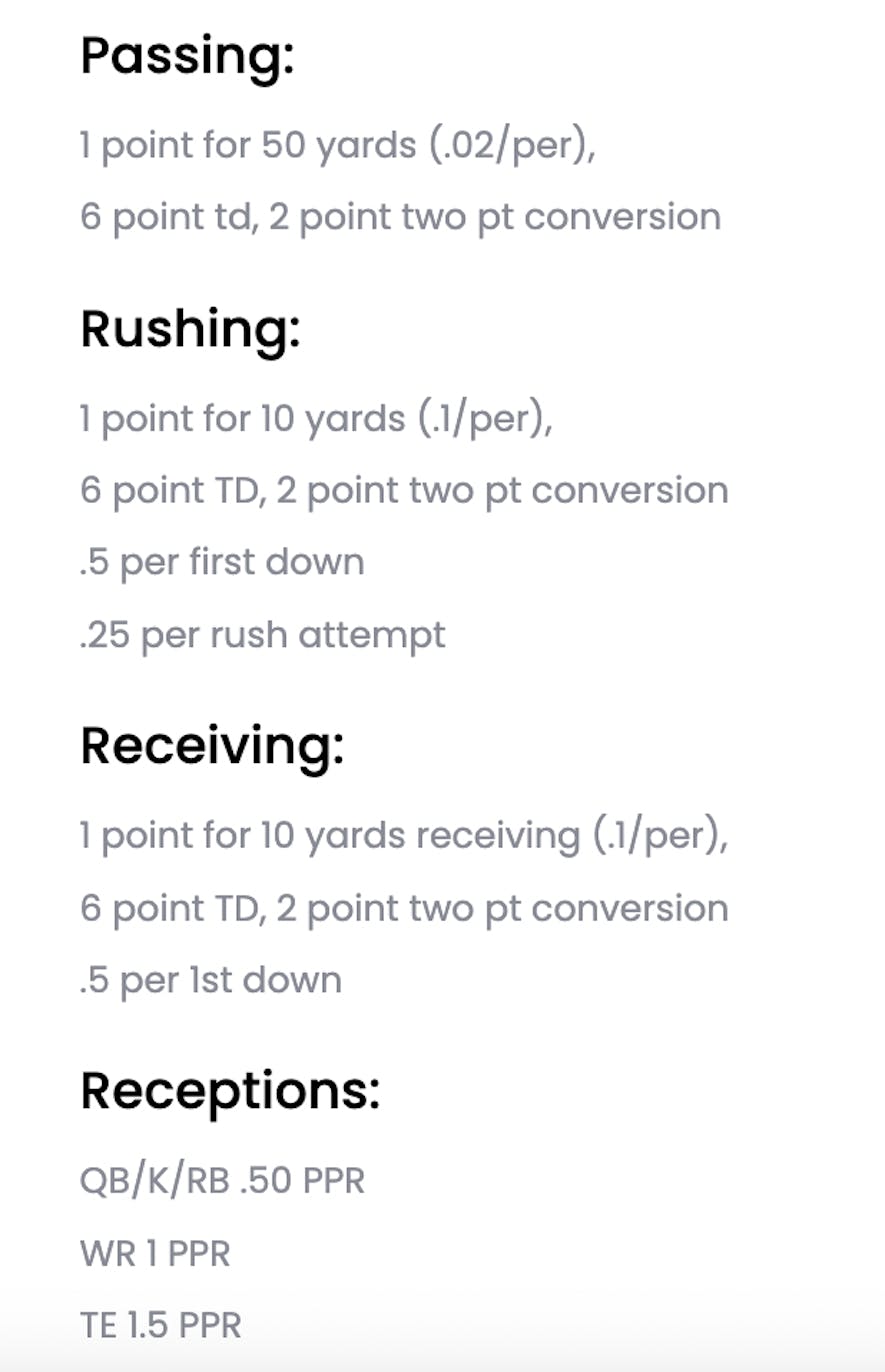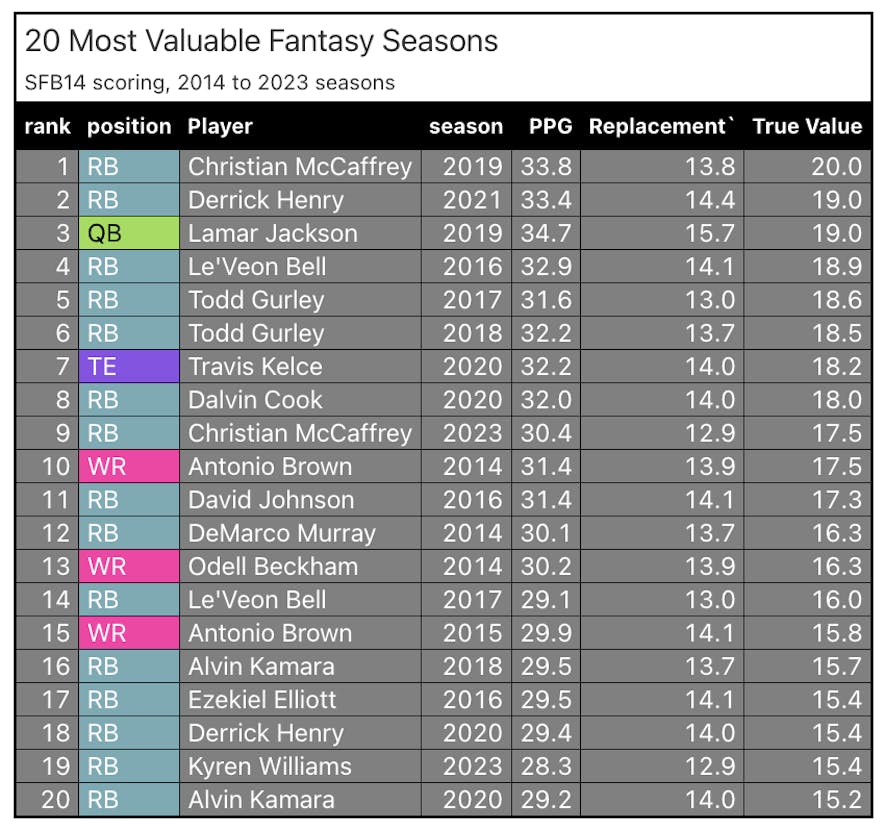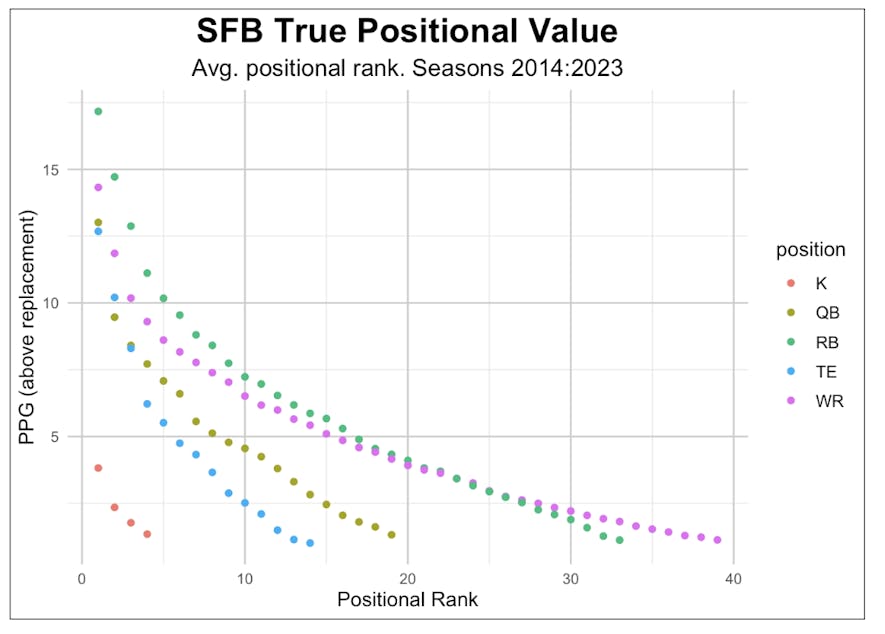
In this Friday's dynasty data article, deep dive on how to prepare for Scott Fish Bowl 14 ("SFB"). While it is not a dynasty league, the prep work required for an SFB draft is identical to the work required to dominate a dynasty startup draft in a league with unique scoring. Plus, the Venn diagram of people reading a dynasty data article in June and those who are either participating in or interested in the Scott Fish Bowl has plenty of overlap. For those participating in Scott Fish Bowl 14, you will definitely find this article helpful. For those not participating, this week's dynasty data article will still be helpful for your next dynasty startup draft -- especially if you are entering a league with unique scoring rules or starting roster requirements.
While many dynasty leagues have straightforward scoring systems, a large (and growing) number of leagues are introducing scoring twists that add an extra layer of complexity. These twists often involve different levels of TE-Premium scoring, points per first down, or points per carry. I firmly believe that one of the biggest keys to success in dynasty leagues is the ability to fully comprehend how your league's specific scoring and roster requirements set it apart from a standard league. If you find yourself in a league with unique scoring or starting roster requirements and your competitors are making their draft picks using generic rankings, you can gain a significant competitive edge by using adjusted player values/rankings.
Helping you build on that edge with new tools and articles explaining how to press this advantage will be a primary focus of this dynasty data series for the rest of the summer.
With that in mind, let's use the Scott Fish Bowl as an example of how we can leverage data analysis to dominate our drafts. We will look at the last decade of NFL stats to identify how we should value each position. In a future article, we will build on this week's analysis to generate SFB14 rankings and a draft strategy to help us finish at the top of the standings.
SFB Scoring
The main reason SFB works so well as an example of how understanding the nuances of the scoring can provide an edge is that the fantasy scoring system is uncommon and changes every season. This is not a cookie-cutter PPR league. Here are the 2024 scoring rules:
As you can see above, the league features several non-standard scoring rules. Passing yards are worth half of what they typically are. There are scoring bonuses for carries, rushing first downs, and receiving first downs. PPR is tiered by position. But it does not stop there.
Adding an extra layer of complexity, the league boosts tight end scoring (above and beyond the tiered PPR) by awarding the position an extra point per first down. SFB14 also features non-traditional kicker scoring and the ability to use kickers in the flex spots. Last, but certainly not least, this year's Scott Fish Bowl adds a massive new twist with scoring that will make punt and kick return specialists as valuable as top performers at other positions.
Step 1: Calculating Past Fantasy Points
Calculating past fantasy points is the first step in understanding how unique scoring should impact our draft strategy. For this article, I used a sample size of 10 years and calculated the total fantasy points scored by every player in each of the past 10 seasons. I always focus my analysis on fantasy points per game (PPG) over total fantasy points, so let's start by simply looking at the 20 best individual seasons over the past decade in this scoring format:
A cursory glance at the raw fantasy PPG scored already provides us with some important insights:
- A whopping 65% of the top fantasy points seasons over the past decade were produced by running backs. No other position had more than 15% of the top seasons.
- Despite the tiered PPR that favors TEs and the extra point for every TE first down, only one season by a tight end ranked in the Top 20. And that was Travis Kelce's ridiculous 2020 season when he racked up 105 catches, 1,416 yards, and 11 touchdowns in 15 games.
- Only three quarterbacks made the list, and each did so on the strength of elite rushing production (more on this below).
- The three wide receiver seasons that made the list came due to a combination of monster receiving numbers combined with solid production as punt returners (more on this below).
Step 2: True Fantasy Value, PPG above replacement
We can do better than simply looking at raw fantasy PPG to measure past fantasy value. A better measure is to compare the fantasy PPG for each player to the replacement-level fantasy production at that player's position. There are different ways to define and calculate "replacement level." I prefer to gauge true value by comparing each player's fantasy PPG to the worst fantasy starter at the position.
Without getting too into the weeds, the way my code does this is to (1) calculate each player's fantasy PPG in the league's specific scoring, (2) filter out players who did not play at least five games, (3) calculate each player's position rank, (4) designate non-flex starters (in the case of SFB14 this would be the top 12 at each of the main positions: QB, RB, WR, and TE since there is only one required starter at each position), (5) rank each of the flex-eligible players (RB, WR, TE, and K) who are not already designated as starters, (6) designate the top 72 (12 teams per league multiplied by six flex spots) as starters, (7) rank each of the superflex-eligible players (QB, RB, WR, TE, and K) who are not already designated as starters, (8) designate the top 12 as superflex starters, (9) look only at the players who are designated as non-flex, superflex, or flex starters and find the lowest-scoring player at each position. This value for each position will serve as our replacement level score, which we will compare all players at the position to.
We can now make a more accurate list of the past decade's 20 most valuable fantasy seasons in SFB14. The "Replacement" column in the table below shows the replacement-level scoring at that player's position in that specific season. The "True Value" column shows the player's fantasy PPG minus the replacement-level production at his position.
After calculating true value, the dominance of elite running backs in SFB14 becomes even more apparent. 75% of the most valuable fantasy seasons of the past decade have been produced by running backs.
The raw data
I will go much deeper into the data below, but I also want to provide the raw data in a format you can play around with yourself if you so desire. To that end, here is a Google sheet with fantasy PPG, replacement level production, positional ranking, and true fantasy production for every player who was a fantasy starter in SFB14 scoring over the past decade:
Step 3: Starting Lineup Insights and Positional Value Conclusions
Our next step is to use these "True Value" numbers to gain an edge on our competition. We can prepare for an SFB14 draft the same way we would a dynasty startup with unique scoring or starting roster requirements. One key element of this process is to compare the historical data (especially True Value) for our league to the same numbers for a more vanilla league.
One way we can do that is to take the sum of the true values for each position over the past decade and compare that to the same numbers for a normal 12-team Superflex league with PPR scoring:
As we can see in the table above, the running back position has been the most valuable overall in SFB14 scoring. The combination of a 0.25-point bonus per carry and a 0.5-point bonus per rushing first down gives running backs a huge positional advantage over the other positions. Tight ends also see a huge increase in value in this format.
A great way to calculate and visualize relative positional value is to look at the average True Value for each positional finish over our 10-year sample. For example, the top running back each year had an average True Value of 17.2. The top WR each year averaged 14.3. We can go all the way down the list. The fifth-best RB (overall RB5) each year averaged 10.2 PPGAR.
The plot below shows the True Value of each positional rank (RB1, RB2, RB3, RB4 ... all the way to RB39) on average for the past decade:
The plot above is key. We see clearly that running back is the most valuable position at every draft level. The top running back has typically outperformed the top quarterback, wide receiver, and tight end. The RB10 had been more valuable than the QB10 or WR10. It is not until we reach WR20 that any position reaches parity with running back.
We also see that the top tight ends have historically been very valuable in this format. In fact, the top three tight ends in any given season have been just as valuable as the top three quarterbacks.
We can now compare what the data tells us about positional value to how people are actually drafting. Let's look at early SFB14 ADP from mock drafts:
Six quarterbacks and one running back are being drafted in the Top 10 overall. However, the data indicates the exact opposite should be true. Historically, the RB6 (9.54 True Value) has been a more valuable fantasy producer than the QB2 (9.47 True Value).
In these early SFB14 mock drafts, the running backs are a screaming value, and the quarterbacks are being vastly overdrafted.
Step 4: Identify the impact on individual players
With our first three steps, we have put ourselves in a position to draw some strong conclusions about positional value and begin to craft a draft strategy to take advantage of market inefficiencies related to the unique elements of our league's scoring and positional requirements. This gives us a major edge on the competition.
However, we can and will go further. This article will be split into two parts. In part two, we will explore how we can go beyond positional insights and identify which players are more valuable within their own positional group in our league than they would be in a vanilla league.
Spoiler alert: In SFB14, we will want to make running quarterbacks and return specialists major priorities on draft day.
Continue reading this content with a ELITE subscription.
An ELITE subscription is required to access content for Dynasty leagues. If this league is not a Dynasty league, you can edit your leagues here.







